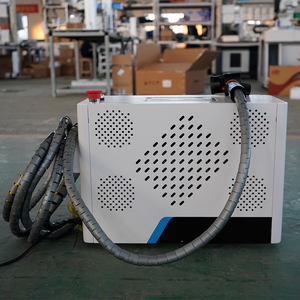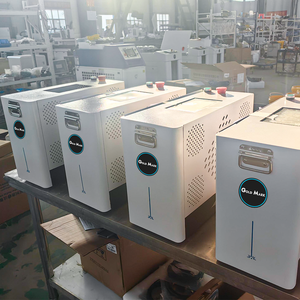(103 products available)












































































































































 Ready to Ship
Ready to Ship



























 Ready to Ship
Ready to Ship














































The spark plug cleaner electric comes in various types, each with unique features to meet different customers' needs. Here are some common types:
Ultrasonic cleaners
This electric spark plug cleaner uses sound waves and a liquid cleaning solution to create millions of microscopic bubbles. The bubbles implode upon contact with a surface, releasing energy that dislodges contaminants. Spark plugs are submerged in a cleaning solution, and high-frequency sound waves are generated by the ultrasonic cleaner. This process thoroughly cleans the spark plugs by reaching all surfaces and removing all deposits.
Sandblasting
Sandblasting is a powerful method that uses compressed air to shoot abrasive materials like sand, grit, or glass beads. When cleaning spark plugs, the sandblasting machine releases abrasive materials at high speed to remove tough deposits and build-up. The spark plug is then blasted, and the abrasive material hits the surface and effectively removes all accumulated deposits.
Wire brushing
This is a traditional method of manually cleaning spark plugs. A wire brush is used to scrape and brush the surfaces of the plugs. This method is especially useful for removing carbon deposits and other contaminants from the electrode and insulator surfaces. The wire brushing technique requires the operator to have experience and be careful not to damage the fragile ceramic insulator or electrode.
Chemical cleaning
Involves using specialized cleaning agents or solvents to clean electric spark plugs. These cleaning agents are made to dissolve and dislodge deposits and contaminants on the surface of the spark plugs. Before the chemical cleaning process, the spark plugs are first soaked in the cleaning agent for a specific time. After that, a brush is used to agitate and remove any loosened deposits. Chemical cleaning is especially useful for stubborn deposits that cannot be removed by other cleaning methods.
Vapour cleaning
Vapour cleaning is a method that uses hot water and cleaning solution vapour to clean electric spark plugs. The electric cleaner generates steam and applies it to the surface of the plug. This process loosens and removes stubborn deposits. The high temperature and pressure of the vapour effectively dislodge contaminants and deposits, making it easy to clean the surface of the spark plug.
Regular Cleaning:
Follow the manufacturer's instructions on how often to clean the electric spark plug cleaner. This is usually based on how much the cleaner is used. Dust and dirt build up on the outside of the cleaner. Wipe these off regularly with a soft cloth. This keeps it looking nice and stops the dirt from interfering with how it works. The inside parts should also be checked. If anything looks like it has a lot of dust or debris built up, remove these loose particles. Cleaning on a regular basis prevents the buildup from affecting how well the spark plug cleaner works.
Inspecting Parts:
Take off the cover or access panels to inspect the electric spark plug cleaner. Check for cracks, rust, or other damage. Worn parts should be replaced with new ones. Loose screws and bolts should be tightened. Moving parts that touch each other should be lubricated.
Checking Electrical Components:
Inspect the electrical cords, switches, and plugs. Look for frayed wires, loose connections, or damaged plugs that need to be fixed or replaced. Make sure the power source is working and the cleaner is getting the right voltage.
Airflow and Ventilation:
Ensure the spark plug cleaner has adequate ventilation and that the air intake and exhaust ports are not obstructed to avoid overheating and maintain optimal performance.
Periodic Maintenance:
Check the manufacturer's manual for instructions on how often to do specific things, like cleaning the inside parts, changing filters, or adding lubrication to moving parts. This is important because different cleaners have different features and require different maintenance schedules.
When buying an electric spark plug cleaner for resale, consider the following factors:
Quality
Prioritize high-quality cleaners that are durable and have reliable performance. A durable cleaner won't wear out after a short time. A reliable cleaner will effectively clean spark plugs without damaging them. Electric cleaners with sturdy aluminum or steel housings are of high quality.
Cleaner's versatility
For retailers, versatile cleaners that come with additional features or attachments are ideal. Such cleaners can do more than just cleaning spark plugs. They may also clean other engine parts or be able to perform abrasive and non-abrasive cleaning.
Power and performance
Consider the power output and cleaning performance of the spark plug cleaner. The power output should be sufficient to clean even the most stubborn carbon deposits. However, the cleaner's power and performance shouldn't exceed the cleaning requirements of delicate spark plugs. Adjustable power settings are a plus.
Portability
Electric spark plug cleaners that are lightweight and cordless are portable. Cleaners that are portable are convenient to use in various locations and tight engine spaces. They are also easy to carry and utilize far from electric power sources.
Ergonomic Design
When choosing a spark plug cleaner for resale, consider the design. Cleaners with comfortable handles and controls that are easy to reach and use are ideal.
Maintenance and Reliability
Buyers should choose cleaners that require minimal maintenance. The reliability of the cleaner is also important, as it will reduce the frequency of repairs or malfunctions.
Safety Features
When buying an electric spark plug cleaner, safety is of utmost importance. Look for cleaners with safety features like overload protection or integrated dust extraction.
Cost
Electric plug cleaners are available at various prices. Buyers should choose cleaners that fall within their budget and offer the best value.
Electric spark plug cleaners are straightforward to use. However, users should read the manufacturer's instructions manual for specific usage instructions. Here are general usage instructions:
Prepare the Spark Plug
Ensure the engine is cooled down before attempting to clean its spark plugs. Then, remove the plug from the engine using a socket wrench.
Inspect the Cleaner
Check that the electric spark plug cleaner is clean and in good working condition before using it on a spark plug.
Connect the Cleaner
Plug the electric cleaner into a power source. Then, secure the spark plug into the cleaner according to the manufacturer's instructions.
Start Cleaning
Turn on the spark plug cleaner and allow it to run for the recommended period. This will depend on the level of dirt and the manufacturer's recommendations.
Inspect the Spark Plug
Once the cleaning is done, the user should turn off the cleaner and remove the spark plug. Thereafter, they should inspect the plug to ensure it is clean and free of particles.
Reinstallation
The user should apply a thin layer of anti-seize compound on the spark plug threads before reinstalling it. Then, they should reinstall the cleaned spark plug into the engine and tighten it securely.
Q: How often should I clean my spark plugs?
A: The cleaning frequency will depend on various factors, such as the engine type, mileage, and driving conditions. Generally, plugs should be cleaned every 10,000 to 30,000 miles. However, users should inspect their spark plugs regularly and clean them when they notice any signs of dirt or deposits.
Q: Can I use a regular wire brush to clean spark plugs?
A: No, wire brushes are not recommended for cleaning spark plugs. They can damage the spark plug's delicate electrode surfaces, leading to poor engine performance. It is better to use a spark plug cleaner electric or a nylon brush, which is gentler.
Q: Is it necessary to remove spark plugs before cleaning?
A: Removing spark plugs before cleaning is highly advisable. It ensures a thorough clean and prevents any debris from falling into the engine cylinder, which could cause damage. Additionally, it allows for a visual inspection of the spark plug condition.
Q: Can a spark plug be cleaned and reused?
A: In many cases, a spark plug can be cleaned and reused. However, if the electrode is severely worn, the spark plug will produce inconsistent sparks, which could damage the engine. Therefore, users should always inspect the spark plugs for visible damage or wear.
Q: What is the best way to clean a spark plug?
A: The best way to clean a spark plug is to use a spark plug cleaner electric. These devices use high-frequency vibrations or sandblasting to remove carbon deposits gently and effectively from the spark plug's surface.